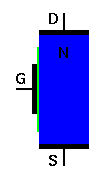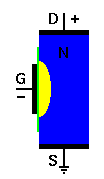Depletion type MOSFET
The channel is of silicon. It can be two type of channel that is an n-type or p-type channel; it is still mostly silicon. After that, we take note that silicon dioxide is simply glass that is a good insulator. Thus we can form a thin layer of silicon dioxide together one surface of the channel, and then lay our metal gate region down over the glass. The result is displayed in the figure.

Sometimes this device is termed as an insulated-gate field effect transistor, or IGFET. More generally, noting the construction of the gate, it is termed as a metal-oxide-semiconductor FET, or MOSFET.
Without voltage applied to the gate (G) electrode, the channel really is only a semiconductor resistance, and will conduct current as per to the voltage applied in between source (S) and drain (D). There is no pn junction, thus there is no depletion region.

With a suitable voltage applied in between source and drain, current will flow via the channel, as a semiconductor resistance. Though, if we now apply a negative voltage to the gate, as displayed in figure, it will amount to a small negative static charge on the gate. This negative voltage will repel electrons, along with their negative charge, away from the gate. However, free electrons are the majority current carriers in the n-type silicon channel. Through repelling them away from the gate region, the applied gate voltage makes a depletion region around the gate area, so restricting the usable width of the channel just like the pn junction did. Since this sort of FET operates by creating a depletion region in an existing channel, it is termed as a depletion-mode MOSFET.